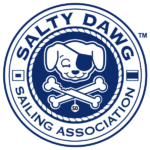 We should have been sitting on an Italian terrace drinking a fine bottle of Chianti, but a global pandemic tends to alter one’s plans. After another summer of sailing up the Eastern seaboard and exploring our favorite state of Maine, we decided to return to The Bahamas for the winter. There were hundreds of Bahamian islands still to discover and while we wanted to remain in our offshore Covid pod, we also wanted to be within striking distance of the US in case the world really fell apart and we had to return to land. We registered again for the annual Salty Dawg Rally—it was wild and unpredictable from the start.
We should have been sitting on an Italian terrace drinking a fine bottle of Chianti, but a global pandemic tends to alter one’s plans. After another summer of sailing up the Eastern seaboard and exploring our favorite state of Maine, we decided to return to The Bahamas for the winter. There were hundreds of Bahamian islands still to discover and while we wanted to remain in our offshore Covid pod, we also wanted to be within striking distance of the US in case the world really fell apart and we had to return to land. We registered again for the annual Salty Dawg Rally—it was wild and unpredictable from the start.
Like most things this year, the 2020 Salty Dawg Rally was remote. There were no Halloween festivities (although plenty of masks!), no evening social hours, no live discussions swapping stories and forming bonds. Friendships were made across the bows of our boats and lectures were presented via Zoom. Each morning, the fleet of 30 captains would appear in their little boxes on computer screens as weather forecasts, fishing advice, and safety tips were relayed virtually. Also different this year were the new protocols for traveling during a pandemic. As Covid rates continued to soar, countries dependent on tourism struggled to balance attracting visitors with keeping their own residents safe. The Bahamas had a three-step requirement with some tricky timing for those of us traveling by sea.
(1) Submit a negative Covid test to obtain a health visa (valid for 7 days).
(2) Present a negative Covid test (within the past 5 days) upon entry into the country (replacing the previous requirement of a 14-day quarantine).
(3) Test negative one final time 5 days after arrival at a Bahamian health clinic.
Sounds reasonable if you’re flying to The Bahamas. But if it takes about five days to sail to The Bahamas, how can you produce a negative test upon entry when you’ve been at sea all that time? And what happens if weather delays either your departure or travel time so that the 7-day health visa expires after your arrival? Tricky, right?
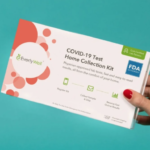
Three weeks before our expected departure, we decided to visit our families since we expected Covid would derail any holiday travel plans AND it would give us a chance to experiment with a home Covid test. We took a deep breath, put on our masks, flew West for some wonderful family time, and let out a big exhale when we returned and tested negative for Covid. The Everlywell home test was deemed easy to use and, most importantly, returned results in a quick 48 hours. Two weeks before our departure, boat repairs and provisioning kicked into high gear, as we planned for possible quarantine or at least remote living in the islands. We rented a car and ran errand after errand—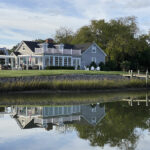 our cupboards with luxuries from Costco and Trader Joe’s, and filling every nook and cranny with a lifetime supply of ramen and marine-grade toilet paper. We painted Gémeaux’s bottom and wrapped her sides in a sleek gray. We cleaned and scrubbed while fresh water was plentiful, repaired sails and rigging, installed a new anchor, and ran the laundry continuously. At the end of each day, sweat dripping from our brow, our land neighbors would appear on their patio with an evening martini, signaling that it was time for us to shower up and toast a shrinking To Do list.
our cupboards with luxuries from Costco and Trader Joe’s, and filling every nook and cranny with a lifetime supply of ramen and marine-grade toilet paper. We painted Gémeaux’s bottom and wrapped her sides in a sleek gray. We cleaned and scrubbed while fresh water was plentiful, repaired sails and rigging, installed a new anchor, and ran the laundry continuously. At the end of each day, sweat dripping from our brow, our land neighbors would appear on their patio with an evening martini, signaling that it was time for us to shower up and toast a shrinking To Do list.
As usual, weather was driving the exact date to leave. From Hampton, Virginia, we needed that 5-day window of favorable weather to reach The Bahamas. Consistent with the 2020 chaos , weather was erratic. Hurricane Zeta had just passed through the East Coast and tropical storms were still brewing in the Atlantic. We were keeping a close eye on newcomer Eta that would ultimately strike Nicaragua as a Category 4 storm and re-emerge…location and temperament TBD. We decided to do an overnight passage to Beaufort, NC to get one day closer to The Bahamas, wait a few days while the next storm passed, and then depart for the islands when our weather router and crystal ball predicted just barely a 4-day weather window before yet another system moved in. We bid farewell to the other Rally boats who all planned to start their journey from Hampton and submitted our Covid tests for the health visa.
 Still recovering from the effects of Zeta, the sea state was rough leaving the Chesapeake at 3am. A big full moon on Halloween Eve and good wind made it more agreeable as we sailed at an average of 8k, reaching a max of 14k when we surfed a wave. We tucked in at the Beaufort City Docks early Sunday morning beside two super-yachts who obstructed our view of the sunset, but also blocked a fierce wind that clocked 40k by 1pm. Covid tests came back negative and our application for the health visa was approved. The 7-day visa clock started ticking.
Still recovering from the effects of Zeta, the sea state was rough leaving the Chesapeake at 3am. A big full moon on Halloween Eve and good wind made it more agreeable as we sailed at an average of 8k, reaching a max of 14k when we surfed a wave. We tucked in at the Beaufort City Docks early Sunday morning beside two super-yachts who obstructed our view of the sunset, but also blocked a fierce wind that clocked 40k by 1pm. Covid tests came back negative and our application for the health visa was approved. The 7-day visa clock started ticking.
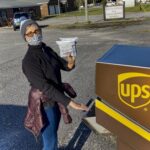 Two days later, as the US polls opened on Election Day, the wind subsided and we were cleared for takeoff. Antigua-bound rally boats departed Hampton, but only one from the Bahamas fleet left—the possibility of Eta reaching them before they reached the islands forced the other boats to postpone their plans. This gave me pause. I knew our southern jumping off point required a shorter weather window but still weather was just a forecast and it was unsettling to know we’d be in the middle of the Atlantic on our own to face whatever weather came our way.
Two days later, as the US polls opened on Election Day, the wind subsided and we were cleared for takeoff. Antigua-bound rally boats departed Hampton, but only one from the Bahamas fleet left—the possibility of Eta reaching them before they reached the islands forced the other boats to postpone their plans. This gave me pause. I knew our southern jumping off point required a shorter weather window but still weather was just a forecast and it was unsettling to know we’d be in the middle of the Atlantic on our own to face whatever weather came our way.  We walked to the UPS box to drop off another round of Covid tests (since the first test results for the health visa were now beyond the 5-day window of our expected arrival). We crossed our fingers that the results would appear in our email when we arrived in The Bahamas AND that we would indeed arrive within five days. We topped off fuel and fresh water and cast off, leaving behind 30-degree temperatures, an internet connection, and political chaos. I put all my faith into our captain (and the UPS pickup schedule) and hoped the day would bring calm—on the seas and at the polls.
We walked to the UPS box to drop off another round of Covid tests (since the first test results for the health visa were now beyond the 5-day window of our expected arrival). We crossed our fingers that the results would appear in our email when we arrived in The Bahamas AND that we would indeed arrive within five days. We topped off fuel and fresh water and cast off, leaving behind 30-degree temperatures, an internet connection, and political chaos. I put all my faith into our captain (and the UPS pickup schedule) and hoped the day would bring calm—on the seas and at the polls.
We motored on a mostly windless first day, but I started a regimen of sea sickness meds, nonetheless, knowing the flat seas wouldn’t last. About two dozen dolphins presented a lively welcome back party, jumping all around the bow of the boat. 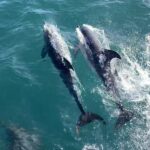 My how I’ve missed the critters of the sea. Just as I thought I would wear a wool hat forever, my toes began to thaw. I stretched out on the rooftop and soaked up the sun. Now in the Gulf Stream—about 60 miles wide at this point—we watched the water temperature increase to 78 degrees. The only sign of civilization were military jets flying over us—practicing, I hoped. After a dinner of chicken burgers and a stunning sunset that turned the sky and sea orange, I declared it bedtime—at 6:15pm. I won’t tolerate any sleep shaming—it’s the only place I find respite from sea sickness and I was determined to fulfill my watch duties, whether they began at 10pm or 2am. Day 1: 110 miles completed; 560 to go.
My how I’ve missed the critters of the sea. Just as I thought I would wear a wool hat forever, my toes began to thaw. I stretched out on the rooftop and soaked up the sun. Now in the Gulf Stream—about 60 miles wide at this point—we watched the water temperature increase to 78 degrees. The only sign of civilization were military jets flying over us—practicing, I hoped. After a dinner of chicken burgers and a stunning sunset that turned the sky and sea orange, I declared it bedtime—at 6:15pm. I won’t tolerate any sleep shaming—it’s the only place I find respite from sea sickness and I was determined to fulfill my watch duties, whether they began at 10pm or 2am. Day 1: 110 miles completed; 560 to go.
 Turned out 6pm was a little early for bedtime—I had trouble falling asleep. Eventually I got a few hours of slumber before the captain woke me at 2am to take over. Foremost on my mind, above weather and the status of the other rally boats, was the Presidential election. Our friend, Courtney, began what would be a steady dispatch of political updates throughout our internet-less journey, and we perked up each time the alarm on our inReach satellite communicator announced an incoming message. Her first report, however, left a pit in my stomach—too close to call. I fixed popcorn, started a new Audible book, and focused on the task at hand—driving Gémeaux. Mild temperatures, calm seas, no squalls, no other vessels around—all I needed to do was stay awake. I proudly did so until 6am when the sound of wind woke the captain. A thin line of strata cumulus clouds appeared low on the horizon, indicating that we had reached the trade winds. We joyfully raised the sails while east winds crept to 22k and clashed with lumpy, confused seas left over from earlier gale force winds from the north. It was like being on Mr. Toad’s Wild Ride, but we were making great southeast progress. Our moods, however, were somber and there was little conversation as the infinite sea forced introspection.
Turned out 6pm was a little early for bedtime—I had trouble falling asleep. Eventually I got a few hours of slumber before the captain woke me at 2am to take over. Foremost on my mind, above weather and the status of the other rally boats, was the Presidential election. Our friend, Courtney, began what would be a steady dispatch of political updates throughout our internet-less journey, and we perked up each time the alarm on our inReach satellite communicator announced an incoming message. Her first report, however, left a pit in my stomach—too close to call. I fixed popcorn, started a new Audible book, and focused on the task at hand—driving Gémeaux. Mild temperatures, calm seas, no squalls, no other vessels around—all I needed to do was stay awake. I proudly did so until 6am when the sound of wind woke the captain. A thin line of strata cumulus clouds appeared low on the horizon, indicating that we had reached the trade winds. We joyfully raised the sails while east winds crept to 22k and clashed with lumpy, confused seas left over from earlier gale force winds from the north. It was like being on Mr. Toad’s Wild Ride, but we were making great southeast progress. Our moods, however, were somber and there was little conversation as the infinite sea forced introspection.
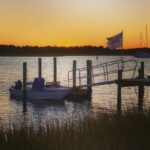 The political angst was just part of a jumbled mix of emotions. I realized, for the first time since that frightful night during our 2016 passage to Antigua when our emergency hatch nearly fell out of the boat, I had some level of fear. My mind wandered and I tried to figure out why. Was it weather? Each time the wind increased I wondered if Eta was upon us. Or would the cold front currently stalled in The Bahamas pick up earlier than its forecasted Saturday arrival? What would happen if we reached The Bahamas only to learn that our Covid tests were positive?! What would happen if our country faced another four years of such divisiveness?
The political angst was just part of a jumbled mix of emotions. I realized, for the first time since that frightful night during our 2016 passage to Antigua when our emergency hatch nearly fell out of the boat, I had some level of fear. My mind wandered and I tried to figure out why. Was it weather? Each time the wind increased I wondered if Eta was upon us. Or would the cold front currently stalled in The Bahamas pick up earlier than its forecasted Saturday arrival? What would happen if we reached The Bahamas only to learn that our Covid tests were positive?! What would happen if our country faced another four years of such divisiveness?
It had been awhile since we were this far offshore and the first time we were heading to another country without a buddy boat or crew onboard. We had made the earlier decision to go solo since this passage was shorter and it was unclear if commercial flights would be available to transport crew back to the US once we arrived. As much as I relish the times when it’s just the two of us, and indeed it was so comfortable and our routines so simple, we were alone.
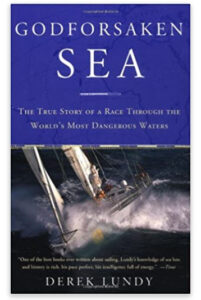 I don’t know what overcame me to start reading The Godforsaken Sea while on a passage myself. I was immediately captivated by this exciting, yet terrifying chronicle of the Vendée Globe—a 4-month sailing race that circumnavigates the globe, including the intrepid Southern Ocean. A true story about all things, far beyond losing an escape hatch, that could possibly go wrong while blue water sailing. Super book choice, particularly when I was at the helm by myself in the dark. Later, Allen and I would confess to each other that we still glance at that damn hatch each time we use the head…just to make sure no water is coming in.
I don’t know what overcame me to start reading The Godforsaken Sea while on a passage myself. I was immediately captivated by this exciting, yet terrifying chronicle of the Vendée Globe—a 4-month sailing race that circumnavigates the globe, including the intrepid Southern Ocean. A true story about all things, far beyond losing an escape hatch, that could possibly go wrong while blue water sailing. Super book choice, particularly when I was at the helm by myself in the dark. Later, Allen and I would confess to each other that we still glance at that damn hatch each time we use the head…just to make sure no water is coming in.
My greatest fear has always been losing Allen overboard. Each time a squall came through and the mainsail needed to be reefed, I would watch him crawl to the mast while seas tossed us back and forth. I’d fix one eye on him and the other on any rogue wave that was sure to sweep him into the sea. I’d play through in my head the required steps to retrieve a man overboard. Mark our position on the chart plotter. Deploy the MOB. Keep a constant eye on the man overboard. Wait! How do I do that when now I have to take down the sails? This is where my heart always sinks. Could I really get the sails down by myself? Could I actually find him in these 12-foot seas in the dark? Naturally, it would be dark because all bad things happen then. I exhaled a sigh of relief as the captain made it safely back to the helm. Day 2: 278 miles completed; 392 to go.
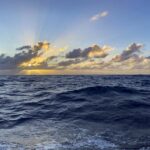 By day three, the comforter came off the bed and the windows stayed open as we ticked off latitudes and closed in on the Bahamas. We had fallen into a routine of eat, sleep, watch, repeat. For me, it was eat, sleep, watch, sleep, and sleep more. No matter how you sliced it, I mostly slept to stave off sea sickness, lying with my tummy firmly plastered to the mattress to avoid moving when the boat shook and rocked. Our watch schedule was loose—Allen would drive until he couldn’t stay awake any longer and then I’d take over. After no sign of life since we left Beaufort, we were back in the shipping lanes and noticed an occasional tanker or even a cruise ship. Wait—cruise ships?! We knew the cruising industry was still shut down so we speculated the cruise ships, which had been anchored in an ocean graveyard since Covid, were moving farther East to avoid Eta. We ate lasagne for dinner (a passage favorite that I prepared before we left) and as Gémeaux churned in heavy seas, the lasagne ricocheted off the sides of the oven. We fixed our mocktails of tonic water and lime over ice and celebrated the end of Day 3: 467 miles completed; 203 to go.
By day three, the comforter came off the bed and the windows stayed open as we ticked off latitudes and closed in on the Bahamas. We had fallen into a routine of eat, sleep, watch, repeat. For me, it was eat, sleep, watch, sleep, and sleep more. No matter how you sliced it, I mostly slept to stave off sea sickness, lying with my tummy firmly plastered to the mattress to avoid moving when the boat shook and rocked. Our watch schedule was loose—Allen would drive until he couldn’t stay awake any longer and then I’d take over. After no sign of life since we left Beaufort, we were back in the shipping lanes and noticed an occasional tanker or even a cruise ship. Wait—cruise ships?! We knew the cruising industry was still shut down so we speculated the cruise ships, which had been anchored in an ocean graveyard since Covid, were moving farther East to avoid Eta. We ate lasagne for dinner (a passage favorite that I prepared before we left) and as Gémeaux churned in heavy seas, the lasagne ricocheted off the sides of the oven. We fixed our mocktails of tonic water and lime over ice and celebrated the end of Day 3: 467 miles completed; 203 to go.
I took over the helm at 2am on the fourth day, stretching out each kernel, each sip, each chapter, to keep me awake. The waning moon was a luxury, lighting an otherwise black void. By daybreak, the scent of shampoo wafted thru the air and I could smell the end of my shift coming soon. Allen appeared freshly showered with his usual, cheerful Good morning!—what a lovely alarm clock. I showered one time during the passage, having found it difficult to stay upright in the shower stall’s washing machine-like conditions. Winds were picking up to a steady 25k and we wondered again if this was Eta making her Atlantic debut. The captain sat quietly at the helm as millions of neurons fired off data points and calculations to assess our present situation. By noon, we decided it wasn’t Eta; just the normal seas and surrounding squalls. Still, winds continued to howl and seas bounced us around, requiring us to constantly adjust the sails.
I could see land on the chart plotter and it was a glorious sight—we were on the home stretch. But which land exactly should we to head to? Green Turtle Cay on Abaco was the closest to the US but required passage through a cut in the reef that would be dangerous in large swell, and certainly not navigable in the dark, which is when we expected to arrive. Romora Bay on Eleuthera’s Harbor Island was the planned destination for the rally and we had already prepaid our stay there. It too had a tricky entrance—the intrepid Devil’s Backbone, named for the very narrow passage between reefs, which would land you on the beach during large swell. We settled on Yacht Haven Marina in Spanish Wells on the leeward side of Eleuthera, offering the best protection from all the predicted swell. We would anchor first at nearby Meeks Patch and then make our way into the marina early Saturday morning before the weather gods really let loose. Initially, we thought we’d reach the anchorage long before midnight but around dinner time, the weather patterns shifted. An evil black wall of clouds spanned the horizon in front of us. I tried to sleep, while the captain kept a close eye on it, but the best I could do was close my eyes as we surfed waves and water pounded the boat like a firing range. No rain ever came and the wind plummeted, forcing us to motor the next hour until wind resumed and the threat was behind us. As we approached Eleuthera around 11pm, our cell phones reconnected and we waded through hundreds of messages and emails, including a negative Covid test. Day 4: 662 miles completed; 8 to go.
We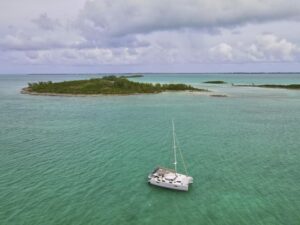 took down the sails just after midnight barely into our 5th and final day and anchored in the dark at Meeks Patch. We joked that even if our anchor dragged, we wouldn’t hit anything since there wasn’t another boat in sight. A toast to safely completing another offshore passage—good girl Gémeaux! We opened the hatch over our berth, which hadn’t been opened since the summer heat in New England, and cool tropical air (and a lot of dust) blew onto us. At 2am, we fell into bed…together. The captain was snoring before his eyelids closed.
took down the sails just after midnight barely into our 5th and final day and anchored in the dark at Meeks Patch. We joked that even if our anchor dragged, we wouldn’t hit anything since there wasn’t another boat in sight. A toast to safely completing another offshore passage—good girl Gémeaux! We opened the hatch over our berth, which hadn’t been opened since the summer heat in New England, and cool tropical air (and a lot of dust) blew onto us. At 2am, we fell into bed…together. The captain was snoring before his eyelids closed.
The winds, as promised, were already shrieking by the time we pulled up the anchor at 9:30 the following morning and I was certain I’d be blown overboard while putting out fenders. We made the short, one-hour trip to Yacht Haven Marina and recalled our first visit earlier this year when we dinghied from the anchorage to provision at the local market. The Bahamian government had just implemented nightly and weekend curfews to curtail the spread of Covid and most businesses were closed.
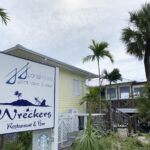 Today, the marina was open, yet still quiet—we shared the space with just two super-yachts. Even at .50/gallon for water and a forecast of rain, we were anxious to bathe our girl and get all the salt off her decks. The customs officer arrived midday to clear in his first victims since the new Covid protocol. Masked and sitting 6 feet away from one another on Gémeaux, we presented our health certificates and our negative Covid tests, promised to test again in 5 days, paid the $600(!) annual cruising permit, and we were official. Just as our meeting ended, I glanced at my phone and learned that we would have a new US president.
Today, the marina was open, yet still quiet—we shared the space with just two super-yachts. Even at .50/gallon for water and a forecast of rain, we were anxious to bathe our girl and get all the salt off her decks. The customs officer arrived midday to clear in his first victims since the new Covid protocol. Masked and sitting 6 feet away from one another on Gémeaux, we presented our health certificates and our negative Covid tests, promised to test again in 5 days, paid the $600(!) annual cruising permit, and we were official. Just as our meeting ended, I glanced at my phone and learned that we would have a new US president.
Wind peaked at 32k in the harbor and rain poured continuously over the next several days, which was exciting to watch now from the safety of a dock. Each morning we woke to an email from the Bahamian government reminding us to fulfill our requirement for the 5-day Covid test. Eventually, marinas would be equipped with the tests but at this early date, we needed to find a local health clinic. That raised our anxiety level. After all the measures we had taken to stay safe, what if we got infected at a clinic?
Turned out the health professionals were just as concerned about US as we stood in an alley at the back door of a medical office and got our noses swabbed. With a final negative test in hand, we were free to travel. All we had to do now was figure out which islands were on lockdown and which areas permitted inter-island travel. Stay tuned for our next update on sailing during a pandemic…
Passage Summary
Miles—670
Hours—88
Water—30 gallons
Fuel—40 gallons
Covid Tests—3
Enjoyed this post?
Sign up to receive email notifications of future posts!

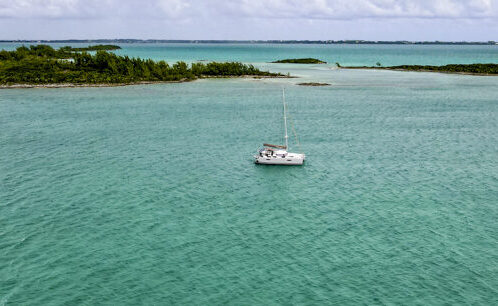
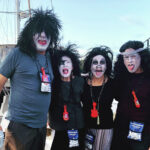
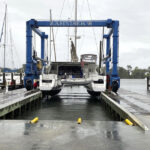
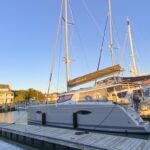
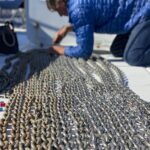

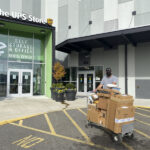
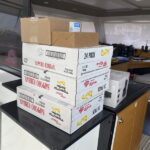
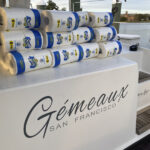
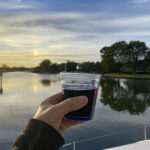
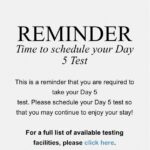
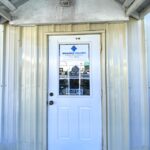
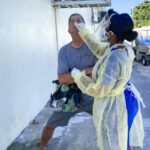
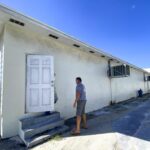
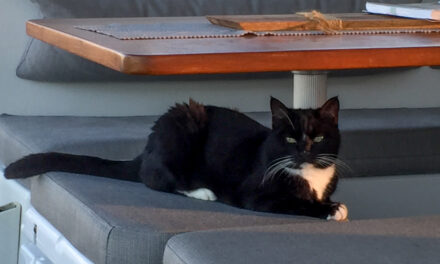

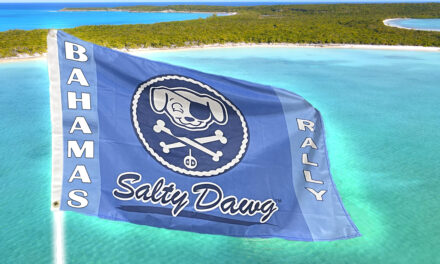
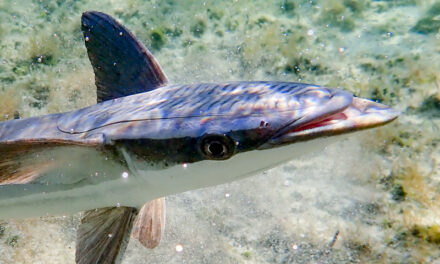


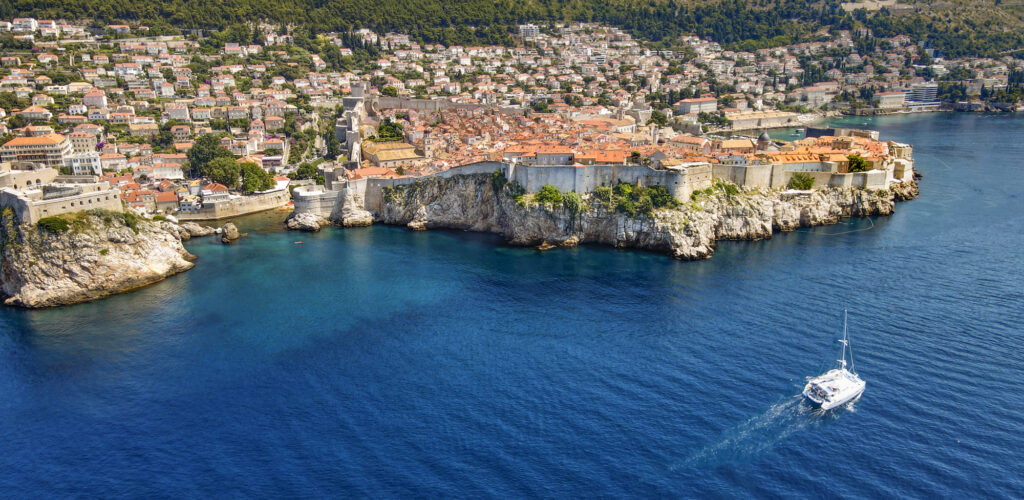
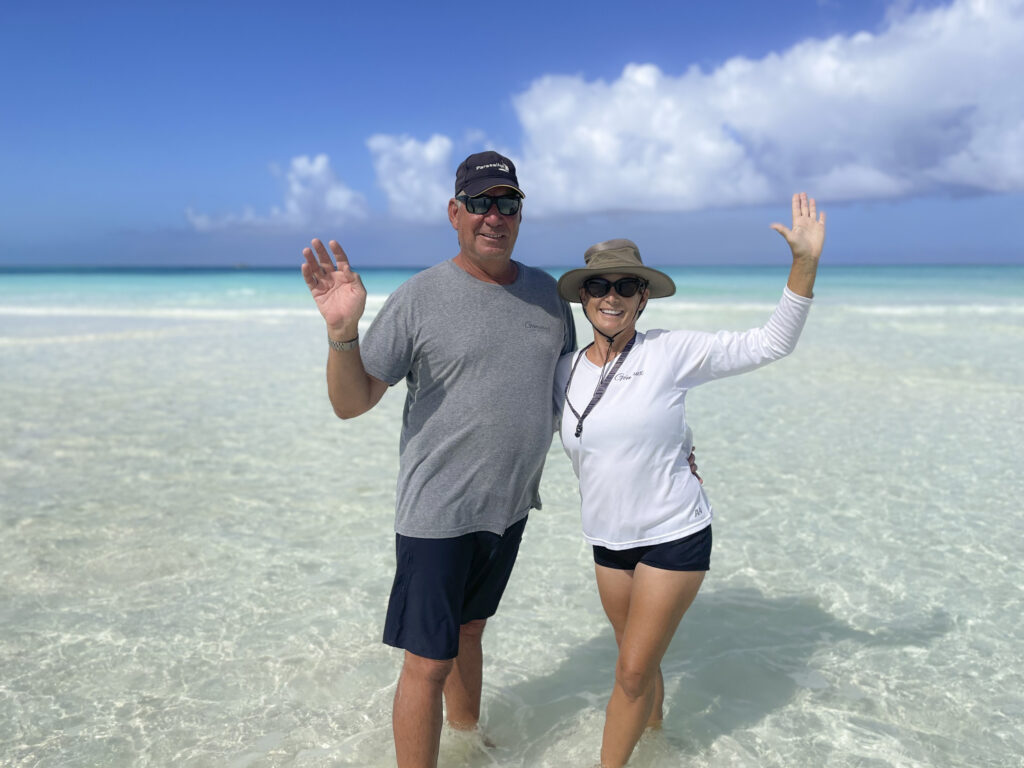
Dear Shiera and ALlen,
What a fabulous description of your passage. I felt like I was right there with you!
It sounds like the rain would have thoroughly washed Gemeaux so I hope you didn’t spend much on water for rinsing the soap off.
What an adventure! We miss you and wish we could have been your buddy boat. So happy that you arrived safely and are now swimming in the warm blue waters with your friends. Love you both!
Wow, Shiera, what a voyage. Thank you for giving us all the details. You are always my beacon for adventure, persistence, and challenges. Glad you are safe.
I’m feeling very queasy now
What a great account, Shiera. Really felt like I was on board with you! So glad the weather cooperated as well as it did, all things considered. Happy sailing to you and Allen! We’ll be thinking of you as we wander the Med, still trying to decide where to spend the winter. There will be better times for that glass of Chianti . . .
Look forward to sharing a glass or 2 with you soon!
Great Blog Post, but best of all you two made it through all the hazards… Of course I mean the testing requirements & procedures! 😉
Shiera – Can’t believe you read “The Godforsaken Sea” or any book like it while on passage! We once jointly read “Little Women” on a passage; it was like eating a 5 lb bag of sugar, but very, very calming, and a good distraction from the Kraken and Storm possibilities!
Well Godforsaken Sea is bound to keep your eyelids open better than Little Women:)
What an adventure! So glad you are safe. As always, wonderful, descriptive writing. Todd & I have always said how fortunate and wise you’ve both been to have spent the better part of the last four years at sea instead of on land in the U.S. I miss you my friend. 🙂
So very glad you are there safe and sound!! Love living vicariously through your stories! You are one of the strongest and bravest women I know- and keep proving that all the time! Hope you have a wonderful time in the Bahamas looking forward to more posts as we hunker down in Arizona. Your perseverance will pay off – blue skies, fresh air- enjoy!!
Ha–sometimes I think I’m a big sissy:)
Glad you have an uneventful trip. We left Beaufort that Tuesday around 5am. Off FL we had to go to 2 reefs to slow down because of the lump from the stream. Usually we can find a bunch of backeddies near shore but we had two knots against us until Miami. We arrived Marathon Friday evening in time for Eta. Hope to get over to the islands this season. Happy cruising.
T. Lee – Jammy
Good to hear from you–we’ll keep an eye out for you in the islands.
Geez — please behave yourselves!! I have enough to worry about here in Georgia without adding you guys to the mix!
Okay–we’ll take care of us and you take care of Georgia! I think you have a tougher job:)
A fabulous & ‘Brilliant’ description of the passage.
Enjoy your little Covid Pod.
Love to you both
Suzanne & David xx
Think most of us have some “should have beens” this Fall that got cancelled but think you win the prize for an alternative path ! Quite a wild ride indeed…while we all must sit, try to stay healthy and get a little bit of isolated outdoor activity.
Love from TX
Pam